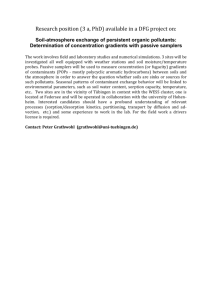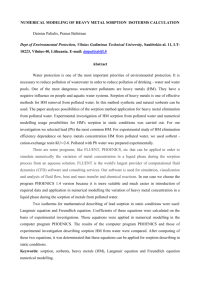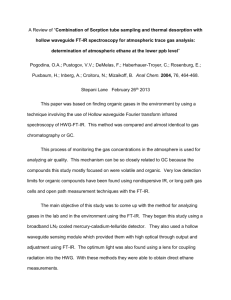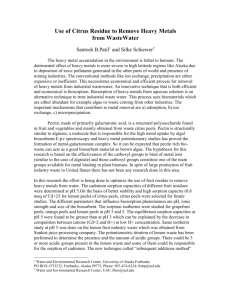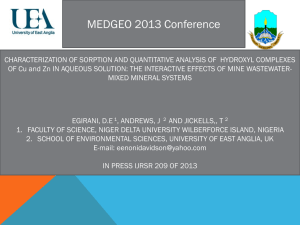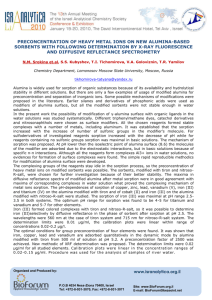Effect of an industrial chemical waste on the uptake
advertisement
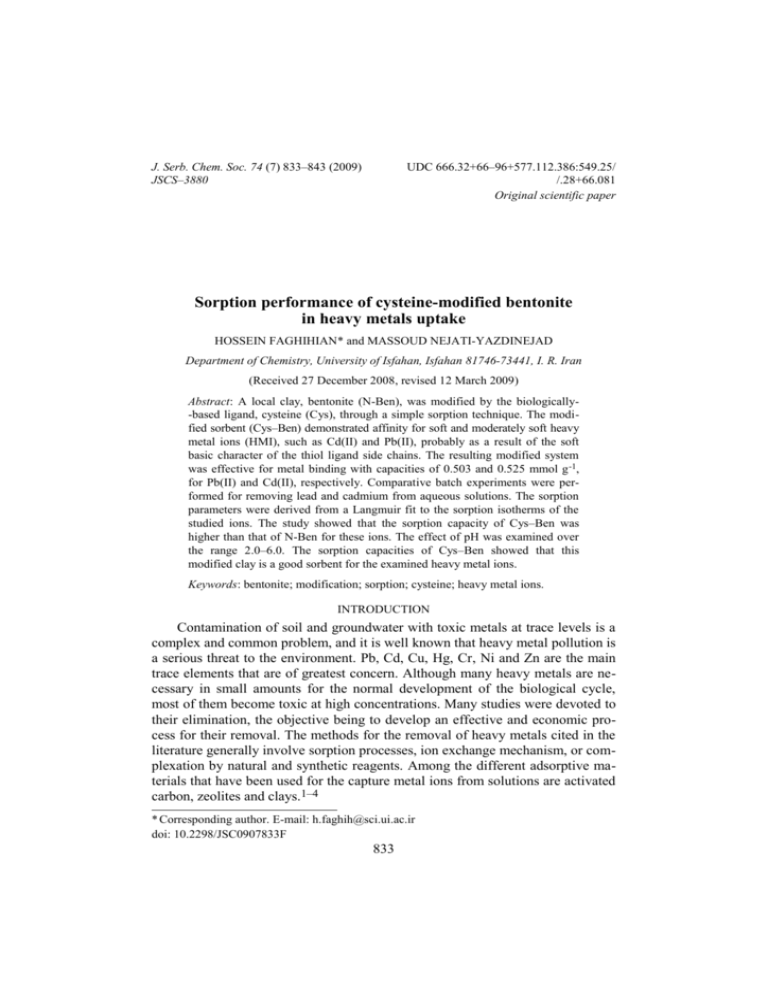
J. Serb. Chem. Soc. 74 (7) 833–843 (2009) JSCS–3880 UDC 666.32+66–96+577.112.386:549.25/ /.28+66.081 Original scientific paper Sorption performance of cysteine-modified bentonite in heavy metals uptake HOSSEIN FAGHIHIAN* and MASSOUD NEJATI-YAZDINEJAD Department of Chemistry, University of Isfahan, Isfahan 81746-73441, I. R. Iran (Received 27 December 2008, revised 12 March 2009) Abstract: A local clay, bentonite (N-Ben), was modified by the biologically-based ligand, cysteine (Cys), through a simple sorption technique. The modified sorbent (Cys–Ben) demonstrated affinity for soft and moderately soft heavy metal ions (HMI), such as Cd(II) and Pb(II), probably as a result of the soft basic character of the thiol ligand side chains. The resulting modified system was effective for metal binding with capacities of 0.503 and 0.525 mmol g -1, for Pb(II) and Cd(II), respectively. Comparative batch experiments were performed for removing lead and cadmium from aqueous solutions. The sorption parameters were derived from a Langmuir fit to the sorption isotherms of the studied ions. The study showed that the sorption capacity of Cys–Ben was higher than that of N-Ben for these ions. The effect of pH was examined over the range 2.0–6.0. The sorption capacities of Cys–Ben showed that this modified clay is a good sorbent for the examined heavy metal ions. Keywords: bentonite; modification; sorption; cysteine; heavy metal ions. INTRODUCTION Contamination of soil and groundwater with toxic metals at trace levels is a complex and common problem, and it is well known that heavy metal pollution is a serious threat to the environment. Pb, Cd, Cu, Hg, Cr, Ni and Zn are the main trace elements that are of greatest concern. Although many heavy metals are necessary in small amounts for the normal development of the biological cycle, most of them become toxic at high concentrations. Many studies were devoted to their elimination, the objective being to develop an effective and economic process for their removal. The methods for the removal of heavy metals cited in the literature generally involve sorption processes, ion exchange mechanism, or complexation by natural and synthetic reagents. Among the different adsorptive materials that have been used for the capture metal ions from solutions are activated carbon, zeolites and clays.1–4 * Corresponding author. E-mail: h.faghih@sci.ui.ac.ir doi: 10.2298/JSC0907833F 833 834 FAGHIHIAN and NEJATI-YAZDINEJAD Effective sorbents with a strong affinity and, consequently, a high loading capacity for the targeted metal ions were prepared by modifying the surface of silica gel, zeolites and clays.5–7 Due to their high specific surface areas, low cost and ubiquitous presence in most soils, clays are usually chosen for the prevention of the release of heavy metals into the environment. One such clay is bentonite, which is a 2:1 type of clay, and its unit layer structure consists of one Al3+ octahedral sheet placed between two Si4+ tetrahedral sheets. The isomorphous substitution of Al3+ for Si4+ in the tetrahedral layer and Mg2+ or Zn2+ for Al3+ in the octahedral layer results in a net negative surface charge on the clay, which give ion exchange property to it.8 Modification may be required to make clay minerals possessing specific sorption and catalytic properties. One of these modification processes is the interaction of the clay mineral with various organic cations and molecules under defined conditions. These modifications are caused by chemical and thermal activation,9 pillaring with inorganic cations10 and surfactant insertion in the interlayer space of the clay.11,12 The association of the clay with complexing reagents (polyphosphate, mercaptobenzothiazole) is a research field which opens interesting perspectives for selectivity of the removal of heavy metals.13 These organic compound can bind to the surface and/or penetrate into the interlayer space of clay minerals as a ligand.14–16 One group of these ligands can be amino acids.17 The concerns of this investigation are divided into two parts: first, the preparation and characterization of modified bentonite and second, an investigation of sorption due to the specific affinity of the thiol group of Cys for the two environmentally important divalent cations Pb(II) and Cd(II) and to examine the practical usability of these modified sorbent in the sorption of these heavy metals from aqueous media. The adsorption features of the studied sorbent were evaluated on the base of sorption parameters derived from the compatibility of the sorption isotherms to the Langmuir model. EXPERIMENTAL Materials and methods Bentonite sorbent was obtained from deposits of the Semnan Region, Iran. The sample was ground in a ball mill and only particles smaller than 71 μm (200 mesh) were used for the sorption experiments. The employed L-cysteine (Merck) had a purity of > 99 %. All the compounds used to prepare the reagent solutions were of analytic reagent grade. The stock solutions of Cd(II) and Pb(II) (1000 mg L-1 for each ion) were prepared by dissolving a weighed quantity of the respective nitrate salt in distilled water. Chemical analysis was performed by X-ray fluorescence (XRF) spectroscopy using a Bruker S4 PIONEER spectrometer. X-Ray powder diffraction (XRD) patterns were collected on a Bruker D8 Advance X-ray diffractometer (CuKα). The specific surface area was determined by the BET method, using a Monosorb surface area analyzer. The IR spectra were recorded in air at room temperature on a Shimadzu infrared spectrophotometer (IR-435). The spectra were measured in KBr pellets. The chemical, mineralogical and physico–chemical charac- CYSTEINE-MODIFIED BENTONITE IN HEAVY METALS UPTAKE 835 teristics of the natural sample are summarized in Table I. The cations in solution were analyzed by a Shimadzu atomic absorption spectrophotometer (AA-670). TABLE I. Physico–chemical, chemical and mineralogical characteristics of the natural sorbent Specific surface area, m2 g-1 CEC / meq g-1 Chemical composition, mass % SiO2 Al2O3 Fe2O3 CaO K2O MgO Na2O TiO2 MnO SrO Loss on ignition Mineralogical composition, mass % Montmorillonite Quartz Feldspar Mordenite Calcite Gypsum 34.6 0.76 60.33 15.63 2.54 2.86 2.52 1.44 1.60 0.43 0.11 0.08 12.51 52.2 25.4 9.6 6.4 4.8 1.5 Preparation of modified bentonite Natural bentonite (5.0 g) was suspended in a 100 mM solution of cysteine, the pH of which had previously been adjusted to 4.0 with HNO3 or NaOH. The obtained suspension was stirred at room temperature for 12 h. The solid phase (Cys–Ben) was separated by centrifugation, washed with distilled water and then dried at room temperature and stored for subsequent studies. The modified bentonite was designated as Cys–Ben.18 Sorption experiments A solution of metal nitrate (100 mL) with a concentration in the range 0.10–10.0 mmol dm-3 was placed in a polyethylene bottle. The pH of the solution was adjusted to the desired value using HNO3 or NaOH solution. An accurately weighed amount of N-Ben or Cys–Ben (1.0 g) was then added to the solution. A series of such bottles was then agitated at a constant speed in a shaking water bath, the temperature of which was kept constant at 25 °C. After a contact time of 12 h (the equilibrium time determined by preliminary experiments), the solid phase was separated by centrifugation. The progress of the sorption was assessed by determining the concentration of metal ion remaining in an aliquot by AAS. All experiments were performed in duplicate. 836 FAGHIHIAN and NEJATI-YAZDINEJAD RESULTS AND DISCUSSION Sorbent characterization The XRD pattern of bentonite is shown in Fig. 1, which indicates that the raw bentonite consisted of montmorillonite and quartz. Fig. 1. XRD Pattern of bentonite (M = montmorillonite, Q = quartz). According to the literature, the sorption of an organic material onto a negatively charged surface is a complex process involving both cation exchange and hydrophobic bonding.19 The modification of the sorbent material after treatment with the cysteine solution was verified by the IR spectra of the materials, which are shown in Fig. 2. The wavenumbers and vibration type of bentonite are given in Table II. The Cys– –Ben spectrum is dominated by the bands of the host material but the presence of the amino acid (on the surface or between the layers) is also observed. Nevertheless, a closer inspection of the 1700–1300 cm–1 of the Cys–Ben and comparison with the same wavenumber interval of the amino acid and that of the host material revealed that the guest species were adsorbed by the sample. Fig. 2. IR Spectra of bentonite, cysteine and Cys–Ben. CYSTEINE-MODIFIED BENTONITE IN HEAVY METALS UPTAKE 837 TABLE II. IR vibrations of bentonite Wavenumber, cm−1 ≈ 3600 ≈ 3400 ≈ 1650 ≈ 1150 ≈ 1050 ≈ 520 Vibration type O–H stretching (Si,Al)–OH O–H stretching H–OH H–O–H deformation Si–O stretching Si–O–Si stretching Si–O–Si deformation In relation to the interaction between bentonite and cysteine, the peaks at 3500–2500 cm–1 are probably N–SH stretching vibration. The broad O–H band (≈ 3500 cm–1) belonging to the carboxyl in the structure is invisible because it is masked by the O–H stretching of the amino acid and water in the bentonite. The spectrum of Cys–Ben showed that the bands at 1340 (symmetric deformation of the NH3 group), 1520 (deformation of the N–H group), 1740 (stretching of C=O), 680 (stretching of C–S) and 2560 cm–1 (stretching of S–H) decreased in intensity.20,21 All these results may be caused by the interaction between bentonite and the NH2 group of cysteine. The TG/DTG curves of bentonite, cysteine and Cys–Ben are shown in Figs. 3 and 4. The bentonite showed a weight loss between 25–200 °C, corresponding to the desorption of internal and external water of hydration.22 Between 200 and 550 °C, the bentonite did not undergo any thermally induced changes. Therefore, the peaks in this region for the organo–bentonite are attributable to the decomposition of the amino acid. The observed weight losses above 450 °C are attributable to dehydroxylation.23 Fig. 3. TG and DTG curve of a) bentonite and b) cysteine. Effect of pH The effect of pH was studied at a constant metal ion concentration (7.0 mmol dm–3) and solid ratio (100 ml g –1) at 25 °C. The pH is an important pa- 838 FAGHIHIAN and NEJATI-YAZDINEJAD rameter for the sorption of metal ions from aqueous solutions because it affects the solubility of the metal ions, the concentration of the counter ions on the functional groups of the sorbent and the degree of ionization of the sorbate during the reaction. The sorptions of Cd(II) and Pb(II) onto Cys–Ben and N-Ben as a function of pH are shown in Fig. 5. Cd(II) and Pb(II) were adsorbed on these sorbents over the pH range 2.0–5.5. It can be seen that the sorption of Cd(II) and Pb(II) is markedly pH-dependent. It is obvious that the amount of the metal ions adsorbed on the solid phase (q) was low at low pH values for both metal ions. This can be explained by the competition of protons for sites on the sorbents. In aqueous solutions, sorbents (bentonite and/or Cys–Ben) with charged groups are susceptible to the experimental conditions such as pH. This usually causes noticeable changes in the sorption of ions onto charged solid sorbents. As the pH of the aqueous phase was lowered (pH < 4), the surface usually become less negative because of protonation of the charged sites. This leads to a decrease in the sorption of cations depending on the sign of the surface charge. The reverse is Fig. 4. TG and DTG curve of Cys–Ben. Fig. 5. Effect of pH on the sorption of a) Pb(II) and b) Cd(II) by the two sorbents. ci = 7.0 mmol dm-3; contact time: 12 h, at 25 °C. CYSTEINE-MODIFIED BENTONITE IN HEAVY METALS UPTAKE 839 true when the pH of the aqueous solution is increased (pH > 4). The value of q increased with increasing initial pH value for both lead and cadmium ions, with a more profound effect in the case of lead ions. It is apparent that using solutions with an initial pH of 4–5 gave the highest q values. Effect of contact time The effect of contact time was studied at a constant metal ion concentration (1.0 mmol dm–3) and a liquid to solid ratio (100 ml g–1) at 25 °C. The obtained results are shown in Fig. 6. It can be seen that the amount of Pb(II) and Cd(II) adsorbed per unit mass of adsorbent (q) showed increased with interaction time. The rate of uptake of Pb(II)/Cd(II) was maximal during the first 12 h, after which it leveled off and equilibrium was attained after 24 h. Maximum metal ion removal values were observed at this contact time. Fig. 6. Effect of contact time on the sorption of a) Pb(II) and b) Cd(II) by the two sorbents. ci = 7.0 mmol dm-3, pH 4.0, at 25 °C. Effect of temperature and thermodynamic parameters When the adsorption equilibrium of the studied systems was established, the metal cation adsorbed was in equilibrium with the residual metal cation remaining in the liquid phase. The values of equilibrium constant (Kd) of the sorption process at different temperatures were calculated from the relation:24 q m (1) Kd e ce V where qe is the equilibrium amount of the metal ions adsorbed on the solid phase, ce is the concentration of the metal ions remaining in solution at equilibrium, m is the mass of the sorbent and V is the volume of the solution. The standard Gibbs free energy (ΔG ) was calculated from the relation:25 ΔG = –RTln Kd (2) The values of the entropy (ΔS ) and enthalpy (ΔH ) changes of the sorption process were calculated by plotting of ln Kd vs. 1/T according to the van't Hoff equation: 840 FAGHIHIAN and NEJATI-YAZDINEJAD ln Kd = (1/R)(ΔS + ΔH /T) (3) The values obtained for Kd, ΔS , ΔH and ΔG are given in Table III. The value of Kd decreased with temperature for both metal ions. The Gibbs free energy change is the driving force and the fundamental criterion of spontaneity. The obtained values of ΔG were –3.64 and –2.12 kJ mol–1 at 25 °C for Cd(II) and Pb(II), respectively. The negative values of ΔG imply that the sorption of these metal ions on the organo–bentonite is spontaneous and becomes more favorable with decreasing temperature. It was reported that ΔG values down to –25 kJ mol–1 are consistent with electrostatic interaction between sorption sites and the metal ions.26,27 TABLE III. Values of the thermodynamic parameters for the sorption of the studied metal ions Sorbent Cys–Ben HMI Cd(II) Pb(II) N-Ben Cd(II) Pb(II) T/K 298 303 313 323 333 298 303 313 323 333 298 303 313 323 333 298 303 313 323 333 ln Kd 1.477 1.427 1.356 1.277 1.224 0.859 0.837 0.817 0.788 0.759 0.033 0.046 0.178 0.301 0.484 0.367 0.372 0.375 0.381 0.383 ΔH / J mol-1 ΔS / J mol-1 K-1 ΔG / kJ mol-1 –5.97 –7.81 –3.64 –3.60 –3.52 –3.44 –3.37 –2.27 –0.490 –2.12 –2.12 –2.12 –2.11 –2.11 10.7 35.9 –0.020 –0.16 –0.52 –0.87 –1.23 0.370 4.30 –0.91 –0.93 –0.97 –1.01 –1.06 The obtained values of ΔS were –7.81 and –2.12 J mol–1 K–1 for Cd(II) and Pb(II), respectively. The negative values of ΔS for both metal ions indicate the decrease in randomness as a consequence of sorption.28 The values of ΔH were –5.97 and –2.27 kJ mol–1 for Cd(II) and Pb(II), respectively. These results show that the sorption of these ions by modified bentonite is an exothermic process. Sorption isotherms The sorption isotherms can be described by a Langmuir-type isotherm, which is described by the following equation: 841 CYSTEINE-MODIFIED BENTONITE IN HEAVY METALS UPTAKE qe Kq 0 ce 1 Kce (4) where q0 is the maximum capacity of the sorbent and K is the Langmuir constant, related to the energy of sorption. The Langmuir equation can be rearranged to a linear form for the convenience of plotting and determining the Langmuir constants as follows: ce ce 1 (5) 0 0 qe q Kq The sorption of Cd(II) and Pb(II) from solution by N-bentonite and Cys–Ben was studied at room temperature at pH 4.0. The sorption isotherms for Cd(II) and Pb(II) were established to compare the sorption capacity of Cys–Ben with that of N-bentonite (Fig. 7). Fig. 7. Sorption isotherms of a) Pb(II) and b) Cd(II) at pH 4.0,; contact time: 12 h, at 25 °C. The equilibrium sorption data were fitted to the linear form of the Langmuir equation, and the determined sorption parameters (q0, K and r2) are given in Table IV. In all cases, the degree of fit, r2, for the linear regression fits were found to be > 0.99, which is a measure of the goodness-of-fit of the experimental data to the Langmuir isotherm model. For both Cd and Pb, higher K values were observed for Cys–Ben than for N-bentonite. The values of q0 and K were calculated from the intercept and slope of the linear plots, respectively. TABLE IV. Lamgmuir parameters for the sorption of the studied metal ions Solute Pb(II) Cd(II) Sorbent N-Ben Cys–Ben N-Ben Cys–Ben K / dm3 mmol-1 3.91 10.3 3.07 5.08 q0 / mmol g-1 0.436 0.503 0.381 0.525 r2 0.9928 0.9917 0.9905 0.9911 842 FAGHIHIAN and NEJATI-YAZDINEJAD The values of q0 (0.503 and 0.525 mmol g–1 for Pb(II) and Cd(II, respectively) are consistent with the experimentally obtained values (Table IV). The values of the Langmuir binding constant (K) were 10.3 and 5.08 dm3 mmol–1 for Pb(II) and Cd(II), respectively. The sorption mechanism of Cys–Ben is complex and the proposed mechanism is probably composed of two successive steps: – an ion exchange step, during which cadmium/lead ions in solution are exchanged with framework ions; – a complexation step, in which the remaining cadmium/lead ions in the solution react with the Cys to form a cadmium/lead cysteine complex.17 Accordingly, the sorption process can be described as follows: An+ + nM-Ben nM+ + A-Ben (6) where M refers to the exchangeable alkali metal ions (i.e. Na+ and K+) of the clay framework, An+ represents heavy metal ions (Cd2+ or Pb2+) and Ben refers to ion-exchange sites of bentonite. CONCLUSIONS Cysteine-modified bentonite (Cys–Ben) was prepared from N-bentonite. The structure and sorption performance of N-bentonite and Cys–Ben were evaluated. Using Cd(II) and Pb(II) as heavy metal indicators for sorption, the experiments proved that the sorption capacities of Cys–Ben were enhanced in comparison to N-bentonite. The pH is an important factor affecting the sorption of heavy metals by bentonite, and it can change the affinity of the sorption sites for heavy metals. The modified mineral had a higher removal efficiency for cadmium than for lead ions, regardless of the operating conditions. A high metal uptake can be achieved using an initial solution pH of 4–5 with a careful selection of the other conditions, especially the metal ion and slurry concentrations, to avoid masking of sorption by chemical precipitation. The Langmuir isotherm provides a good fit for the studied temperature and concentration ranges. Acknowledgements. This study was completed at the University of Isfahan and supported by the Office of Graduate Studies. The authors are grateful to the Office for their support. ИЗВОД СОРПЦИОНЕ КАРАКТЕРИСТИКЕ БЕНТОНИТА МОДИФИКОВАНОГ ЦИСТЕИНОМ ПРИ УКЛАЊАЊУ ТЕШКИХ МЕТАЛА HOSSEIN FAGHIHIAN и MASSOUD NEJATI-YAZDINEJAD Department of Chemistry, University of Isfahan, Isfahan 81746-73441, I. R. Iran Локална глина бентонит (N-Ben) модификована је биолошким лигандом цистеином (Cys) једноставном сорпционом техником. Модификовани сорбент (Cys–Ben) показао је афинитет према јонима меких и умерено меких тешких метала као што су Cd(II) и Pb(II), што је вероватно резултат умерено базног карактера периферних тиолних ланаца лиганда. CYSTEINE-MODIFIED BENTONITE IN HEAVY METALS UPTAKE 843 Резултујући модификовани систем био је ефикасан за везивање метала капацитетима од 0,503 и 0,525 mmol g-1 за Pb(II) и Cd(II), редом. Изведене су упоредне групе експеримената уклањања олова и кадмијума из водених раствора. Сорпциони параметри добијени су уз претпоставку да сорпција испитиваних јона одговара Langmuir-овој адсорпционој изотерми. Испитивање је показало да је сорпциони капацитет сорбента Cys–Ben за ове јоне већи у односу на капацитет сорбента N-Ben. Утицај pH испитиван је у опсегу 2,0–6,0. Добијени сорпциони капацитети показали су да је Cys–Ben добар сорбент за испитиване јоне тешких метала. (Примљено 27. децембра 2008, ревидирано 12. марта 2009) REFERENCES 1. A. M. Garcia, V. G. Serrano, M. F. Franco, C. V. Calahorro, J. Hazard. Mater. 103 (2003) 141 2. J. Perić, M. Trgo, N. Medvidović, Water Res. 38 (2004) 1893 3. T. Saitoh, F. Satoh, M. Hiraide, Talanta 61 (2003) 811 4. S. E. Bailey, T. J. Olin, R. M. Bricka, D. D. Adrian, Water Res. 33 (1999) 2469 5. H. H. Tran, F. A. Roddick, J. A. O’Donnell, Water Res. 33 (1999) 2992 6. C. F. Lin, S. S. Lo, H. Y. Lin, Y. Lee, J. Hazard. Mater. 60 (1998) 217 7. F. Barbier, G. Duc, M. P. Ramel, Colloids Surf. A. 166 (2000) 153 8. D. W. Breck, Zeolite Molecular Sieves, John Wiley Inc., New York, 1974 9. E. G. Pradas, M. V. Sanchez, F. C. Cruz, J. Chem. Technol. Biotechnol. 59 (1994) 289 10. W. Matthes, F. T. Madsen, G. Kahr, Clays Clay Miner. 47 (1999) 617 11. S. H. Lin, R. S. Juang, J. Hazard. Mater. 92 (2002) 315 12. A. A. Atia, Appl. Clay Sci. 41 (2008) 73 13. Y. I. Tarasevich, G. M. Klimova, Appl. Clay Sci. 19 (2001) 95 14. V. Balek, Z. Malek, U. Ehrlicher, K. Gyoryova, Appl. Clay Sci. 21 (2002) 295 15. F. Bergaya, G. Lagaly, Appl. Clay Sci. 19 (2001) 1 16. A. Parbhakar, J. Cuadros, M. A. Sephton, W. Dubbin, Colloids Surf. A 307 (2007) 142 17. L. G. Sillen, A. E. Martell, Stability Constants of Metal-ion Complexes, Chem. Soc., London, Alden, Oxford, 1971 18. H. Faghihian, M. Nejati-Yazdinejad, Clay Miner. 44 (2009) 125 19. Z. Li, R. S. Bowman, Environ. Sci. Technol. 31 (1997) 2407 20. A. Pawlukojc, J. Leciejewicz, A. J. Ramirez, Spectrochim. Acta A 61 (2005) 2474 21. L. O. B. Benetoli, C. M. D. Souza, D. A. M. Zaia, Origins Life Evol. B. 37 (2007) 479 22. H. He, Z. Ding, J. Zhu, Clays Clay Miner. 53 (2005) 287 23. W. Xie, Z. Gao, K. Liu, W. P. Pan, R. Vaia, Thermochim. Acta 368 (2001) 339 24. G. W. Beall, Appl. Clay Sci. 24 (2003) 11 25. A. Seker, T. Shahwan, A. E. Eroglu, S. Yilmaz, Z. Demirel, M. C. Dalay, J. Hazard. Mater. 154 (2008) 973 26. G. M. Haggerty, R. S. Bowman, Environ. Sci. Technol. 28 (1994) 452 27. K. Al-Dalama, B. Aravind, A. Stanislaus, Appl. Catal. A 296 (2005)49 28. S. I. Lyubchik, A. I. Lyubchik, O. L. Galushko, L. P. Tikhonova, J. Vital, I. M. Fonseca, S. B. Lyubchik, Colloids Surf. A 242 (2004) 151.
